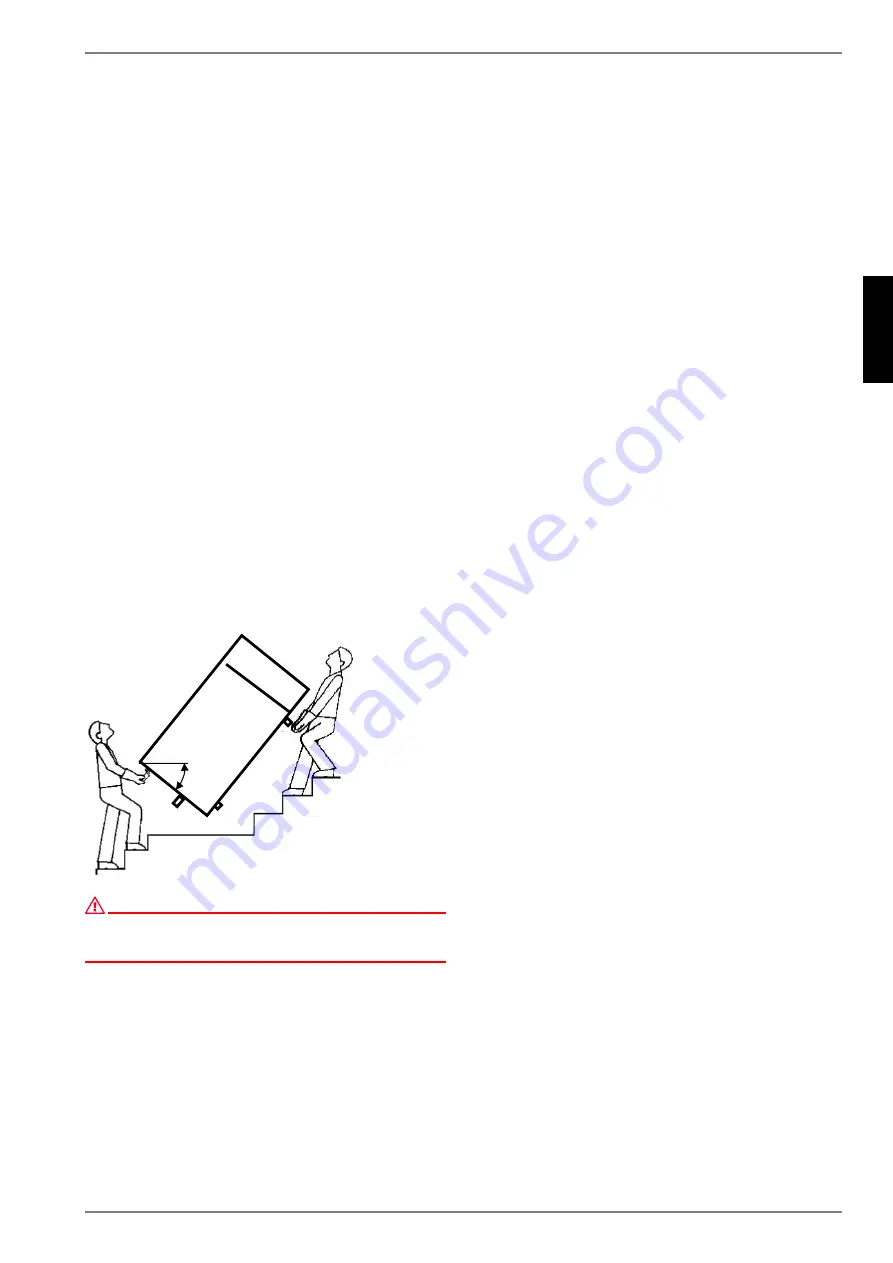
www.dimplex.de
E-5
English
4.1
3 Storage and Transport
3.1 General Conditions
The HW HP should always be stored and transported in an up-
right position
without being filled with water
. If handled care-
fully, the unit can be transported over short distances with a max.
tilt angle of 45°. Ambient temperatures between -20 and +60 °C
are permissible during transport and storage.
3.2 Fork Lift (or Lift Truck)
Transport
The HW HP must remain mounted on the pallet when being
transported via a fork lift. The pump should be lifted slowly. Be-
cause of its high centre of mass, the HW HP must be secured
against canting. To prevent damage, the HW HP must be low-
ered onto a level surface.
3.3 Manual Transport
The wooden pallet can be used to manually transport the heat
pump from below. A second or third carrying position can be cre-
ated with the help of ropes or carrying slings (these may be
wrapped around the hot water cylinder casing and attached to
the water pipe nipples). When transporting the heat pump in this
manner (or with a hand truck), do not, under any circumstances,
exceed the
max. tilt angle of 45°
(see illustration). If the heat
pump can only be transported in a tilted position, the HW HP
(“heat pump” switch) should not be operated for at least one hour
after installation in its final location.
ATTENTION!
The device cover cannot be used for carrying (the cover cannot withstand
larger forces! The strain on the device cover must be relieved during
transport using suitable measures or devices).
4 Set-Up
4.1 Installation Location
Installation location criteria:
The HW HP must be installed in a
frost-free and dry room
.
Both the room temperature and the air drawn in by the HW
HP should be within a temperature range of 15 °C to 35 °C
(required for heat pump operation).
Installation
is
also
not permitted
in rooms with air that is po-
tentially explosive due to gases, vapours or dust.
Good thermal insulation from the neighbouring rooms is rec-
ommended.
Condensate drainage (with a siphon) must be provided.
Drawn-in air must not be excessively contaminated or con-
tain large amounts of dust.
The load-bearing capacity of the foundation must be suffi-
cient (the weight of the filled HW HP is approx. 410 kg!).
There must be a minimum clearance of 0.6 m on all sides of the
device to facilitate maintenance and repair work. If the HW HP is
mainly operated as hot water device and not as a ventilation de-
vice, i.e.
without air ducts/hoses or bends
(
Î
“free venting”),
a minimum room height of 2.5 m is required for effective opera-
tion. As an option, the HW HP can also be connected using the
insulated ductwork of the NW 160. The max.
total
length of the
ductwork may not exceed 10 m.
The following information must be observed when connecting the
HW HP to exhaust air systems:
Standardised exhaust air systems:
Standardised exhaust air distribution systems with decentralised
outside air valves are available for the HW HP. These systems
are connected to the device using a flexible air duct equipped
with sound and thermal insulation (DN 160). This air duct is used
for both the exhaust air as well as for the outgoing air.
The installation instructions for the respective exhaust air system
must be observed.
If it is possible that the operating noise of the system might be
transmitted into exhaust air rooms located in the immediate vicin-
ity (e.g. in the case of very short air duct routes), an additional
suitable duct sound absorber (DN 160) must be installed on the
exhaust air side of the compact domestic unit.
Individual exhaust air systems:
If rigid ducts (e.g. folded spiral-seam ducts, flat ducts) are used
for the exhaust air system, a flexible transition (e.g. flexible duct
pieces with a length of approx. 1 m) must be used between the
duct system and the exhaust air and outgoing air stubs of the de-
vice to ensure that there is adequate vibration isolation.
A suitable duct sound absorber must be used on the exhaust air
side to prevent the operating noise of the ventilation unit from
being transmitted.
Summary of Contents for LBW 300
Page 2: ......






























